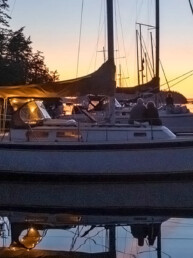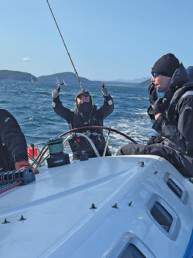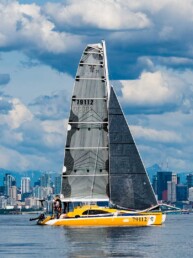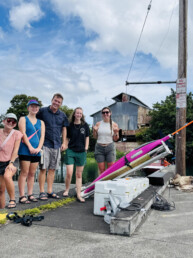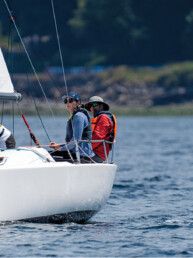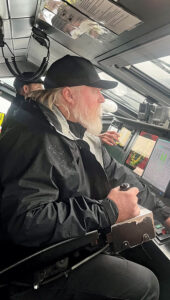
Captain Tom Healy looks forward to winter. Settling into his captain’s chair on the bridge of the Finest, a Kitsap Transit fast ferry, one afternoon in early December, he gestures through the windshield. Wind roughens the slate-gray waters, a chilly drizzle spatters against the windshield, and fog limits our visibility to about half a mile. “We have the whole field to ourselves,” he says with satisfaction.
Healy looks the part, with a comfortably weathered face, full white beard, and long white hair flowing from under his black ball cap. On most days, his job is to pilot a high-speed catamaran, cruising between 28 and 35 knots — along with its passengers, on foot or traveling by bicycle, scooter, skateboards, or some other device in the ever-growing array of portable wheeled transport — from Kingston to Seattle and back again three times a day. Even with the nasty weather, the beginning of an atmospheric river, it’s an easier job in December than it is in July.
As anybody who traverses or lives along these waters knows, on a summer day they fill with pleasure craft. Small recreational fishing boats trolling at 1 to 3 knots scatter along the shipping lanes; sailboats pour out of Shilshole Bay, Edmonds, and other marinas, beating, reaching, and running in every direction; and cruisers of all stripes plow up and down the Sound. This all means more headaches for Healy.
I confess that, one day last summer, I became part of the problem. I left my slip in Kingston at noon to catch the incoming tide, hoping it and a 12-knot breeze from the north would carry my Westsail 28, Tuaq, nicely to one of the mooring buoys at Blake Island. South of Point Jefferson, I decided to jibe, changing my heading from southeast to southwest, to try to catch a fresher breeze. I had threaded through most of the fishing fleet, but there were several sailboats ahead of me beating up the channel. As I pushed the tiller over, I remember noting that these sailboats had the right-of-way, since I would be on a port tack and windward of all of them.
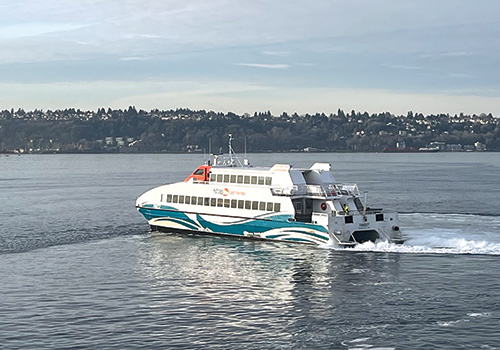
As my course changed and the boom snapped across, I heard the loud blast of a ship’s horn right behind me. I wheeled around, the jib flapping angrily and the unreleased main heeling me well over, to find a fast ferry bearing down, its twin pontoons pointed at me like the prongs of a carving fork. Focused on what lay ahead, I had neglected to look astern before I jibed. I had turned right into the ferry’s path.
Once I was clear of the ferry and my heart rate dropped back down, I decided it was time to learn more about these sleek, swift vessels. What does the Salish Sea look like from the bridge of a fast ferry? And, more importantly, what should I and other pleasure boaters know about the best way to operate safely around them? To answer these questions, I set up a ride-along with Captain Healy and his crew on Kitsap Transit’s Kingston to Seattle run.
Kitsap Transit is the largest operator of passenger-only ferries on Puget Sound. Following voter approval in 2016 of a 0.3-percent sales tax to fund the service, the agency has built its fleet to include seven high-speed catamarans providing service on weekdays (and Saturdays in the summer) to and from Seattle on three routes: six round-trips from Kingston; eight round-trips from Southworth; and two boats providing 20 round-trips from Bremerton, partially making up for reduction in service to one boat on that route by the Washington State Ferries. In the first quarter of 2023, ridership had increased 66% from a year earlier, with about 2,400 boardings per day. (The agency also operates two foot ferries linking Annapolis and Port Orchard with Bremerton.)
King County also operates passenger-only ferries, which it calls “water taxis,” between Seattle and Vashon Island, and Seattle and West Seattle, on regular weekday schedules. The two agencies currently share Pier 50 in Seattle, a facility owned by King County, although Kitsap Transit is exploring the possibility of developing its own terminal in Seattle, with the current favorite being Pier 48. Once the agency has a new facility, it will pursue its plans to develop an “Electric Fast Foil Ferry” capable of making the 30-mile round-trip to Bremerton on one battery charge.
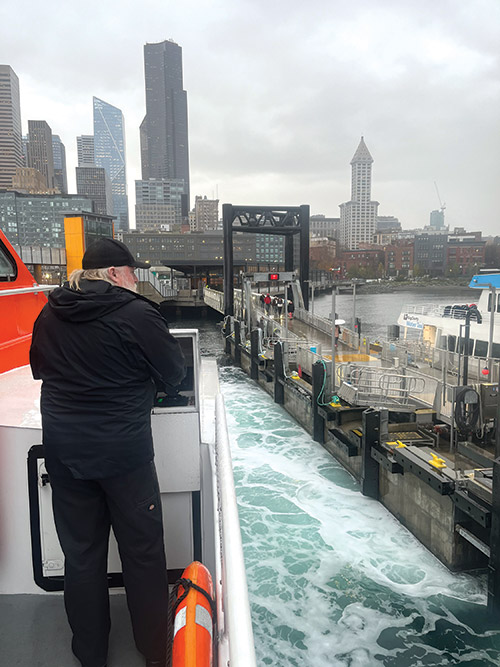
My ride-along with Captain Healy took place on the Finest. Built in 1996, the boat is the oldest in the agency’s fleet of fast ferries. (The agency’s oldest vessel, a foot ferry, is the delightful Carlisle II, built in 1917 and one of only two operational vessels from the Mosquito-fleet era.) Acquired from New York — the name Finest refers to the NYPD — and refurbished in 2018, it has a length of 114 feet, a beam of 33 feet, and can carry 349 passengers. Its top speed is 32 knots and it can stop in less than four boat lengths.
The other vessels in the fast ferry fleet include: the Commander, built in 2021 and usually used on the Kingston route, and its sistership the Enetai, built in 2020 and serving Southworth; the Reliance and the Lady Swift, also sisterships, built in 2019 and serving Bremerton; and the Rich Passage 1, the agency’s first fast ferry, built in 2010 and serving Bremerton. The agency also acquired the Solano from an agency serving San Francisco Bay and is currently refurbishing it as a backup vessel. The newer boats have cruising speeds of up to 38 knots, although the “service speed” — that is, the speed the ferries need to make to cross on schedule — is 28 knots.
As Healy brings the Finest up to speed and heads out of Kingston Harbor, he takes out a cloth and patiently gives the windshield’s foggy glass a wipe. “I’m not saying it’s every boat I ever worked on, but pretty close,” he says, referring to the weak defogger. He turns to a deckhand standing behind him. “You can be the wiper,” he jokes. “Do you have that certification?” He turns to me to explain that “wiper” is usually a position in the engine room. “But not today.”
Healy, 60, has been working on boats since he was a teenager in Southern California with a dream of a charter fishing boat of his own. That became a reality in his early 20s. Then, in the summer of 1989, with the Valdez oil spill in Alaska’s Prince William Sound, he discovered more lucrative ways to use his captain’s license and ended up running a variety of vessels, including tugboats, university research vessels and, for eight years, the Victoria Clipper.
He has worked for Kitsap Transit for six years and plans to continue with the agency until he retires. For a professional mariner who has spent years offshore, sleeping in your own bed every night and living only 20 minutes or so from your home port is hard to beat. In addition, the agency allows its employees some flexibility, within reason, to create their own schedules. With the agreement of the other captain on the Kingston route, Healy takes the morning runs one week and the afternoon runs the next.
As we pass the “Sierra Foxtrot” or “SF” buoy marking the center of the shipping lanes east of President Point, Healy points to the large radar screen and shows me the image of a tug with a barge in the channel up ahead, not yet visible to us in the fog. He notes its speed and direction and alters our course slightly to increase the “CPA,” or closest point of avoidance. He also points out a small spot on the screen just off Jefferson Head, the only pleasure boat we’ll encounter on this run, although we’ll never see it in the fog. “Probably not a sailboat,” he comments, noting that it is traveling about seven knots straight into the wind.
I ask how much flexibility they have in choosing their routes on each trip. “We generally stay in the traffic lanes, although we have a lot of flexibility if we inform Seattle traffic of our intentions,” he tells me. The ferry might depart from its lane, for example, to accommodate other ship traffic, especially around buoys, or to take a more comfortable course in certain weather and sea conditions. For example, when “it’s going good out of the northwest,” Healy will cut inside the “SF” for a more comfortable course into Kingston.
I ask him what he would tell recreational boaters about operating around the fast ferries. “Maintain course and speed,” he says. Generally, he tells me, the skipper will “already have a tag on a boat” and has set a course to avoid it, so long as it doesn’t make any changes.
“You can tell the moment the lights go on,” he says with a laugh when I tell him about my own experience. “But I’m a boater myself, so I know how it is. We’re the professionals in the situation and it’s important to make decisions that don’t put anybody at risk.”
I’m impressed, as we travel through these familiar waters, by the vigilance of Healy and the other crewmembers. Even though they have traveled this route numerous times, they are plainly engaged in their work, paying the same close attention as if these waters were new to them. It is a good lesson for an amateur like me.
I ask him how often recreational boaters hail him on the VHF radio to discuss passing arrangements. “Rarely,” he replies. “Generally, it’s the people who are more serious.” Like all commercial vessels, the fast ferries monitor Channel 14 and Channel 13. Channel 14 is the channel used by the Coast Guard’s Seattle Traffic Center, commonly known as “Seattle Traffic,” south of the “SC” Buoy off Bush Point on Whidbey Island. North of this point and on the east side of Whidbey, Seattle Traffic uses Channel 5A.
Channel 13 is used for bridge-to-bridge communications and making passing arrangements. This is the best way to hail the ferries directly, although Seattle Traffic will often relay attempts to call the ferry on Channel 16. I made a mental note to expand my own monitoring beyond Channel 16.
I ask him what type of pleasure boater behavior causes the most problems for the Kitsap Fast Ferries. “In the summer, we get cut off on a daily basis,” he says without hesitation, and the two deckhands on the bridge nod in agreement. “I can see it on the radar, somebody looping way out in front” as they try to outrun the fast-moving ferry. He notes that a safer practice, and one that would not cost much, if any, additional time, would be to slow down and take the ferry’s stern.
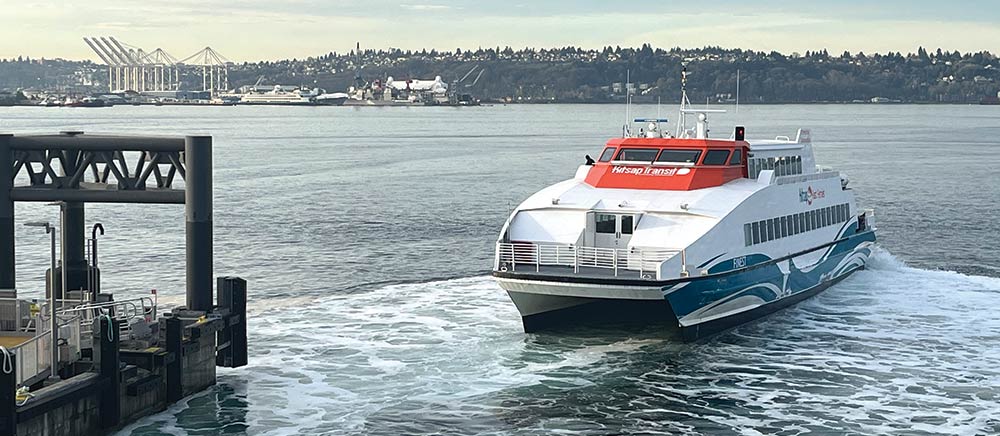
“I also see a lot of what I call ‘point-to-point’ navigators,” he says. He explains that these are boaters who navigate from one point of land to the next, for example, coming out of Shilshole Bay Marina and setting a course for Point-No-Point. Given the configuration of the traffic lanes, such a course means that they cross the traffic lanes at a shallow angle, thus spending a lot of time in the danger zone. He recommends that boaters consider choosing a course to comply more closely with Rule 10 of the Collision Regulations (ColRegs), which provides that a “vessel, shall so far as practicable, avoid crossing traffic lanes” and that, when it does cross the lanes, shall do so “on a heading as nearly as practicable at right angles to the general direction of traffic flow.” Under this rule, boaters might, for example, head up the east side of the TSS lanes from Shilshole to the SF Buoy near Kingston, then cross the lanes perpendicularly to the other side (staying clear of the Kingston-Edmonds state ferry lane), where they would continue up the west side of the channel to Point-No-Point.
This applies even more strongly in the narrow confines of Rich Passage, where currents can be strong and the boat traffic heavy. Here, he suggests that recreational boaters stay as far to the right (near shore) as possible.
One further note as we pull into the dock: the fast ferries are very predictable. According to the agency’s website, they arrive within five minutes of their scheduled times 98 to 99 percent of the time. So, a quick look at the website should eliminate surprises like the one I experienced last summer.
Lessons learned.
TIPS FOR BOATING AROUND FAST FERRIES
- Look aft as well as forward, particularly when changing course.
- Maintain course and speed until the ferry has passed.
- Around shipping lanes, monitor VHF Channel 14 for traffic information (5A to the north) and Channel 13 for passing arrangements.
- If in doubt, hail the ferry on Channel 13.
- As much as possible, stay out of traffic lanes and cross them at right angles.
- Slow down and let the ferry pass ahead of you — don’t make it a close call!
Devin Odell is a retired judge who has taken up sailing on his Westsail 28. His homeport is Kingston, Washington, and he frequently plies the waters of Puget Sound between Port Townsend and Tacoma.


